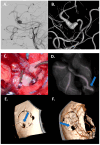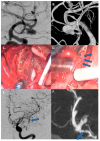Navigating Complexity: A Comprehensive Approach to Middle Cerebral Artery Aneurysms
- PMID: 38592120
- PMCID: PMC10931706
- DOI: 10.3390/jcm13051286
Navigating Complexity: A Comprehensive Approach to Middle Cerebral Artery Aneurysms
Abstract
Background: The concept of aneurysm "complexity" has undergone significant changes in recent years, with advancements in endovascular treatments. However, surgical clipping remains a relevant option for middle cerebral artery (MCA) aneurysms. Hence, the classical criteria used to define surgically complex MCA aneurysms require updating. Our objective is to review our institutional series, considering the impacts of various complexity features, and provide a treatment strategy algorithm. Methods: We conducted a retrospective review of our institutional experience with "complex MCA" aneurysms and analyzed single aneurysmal-related factors influencing treatment decisions. Results: We identified 14 complex cases, each exhibiting at least two complexity criteria, including fusiform shape (57%), large size (35%), giant size (21%), vessel branching from the sac (50%), intrasaccular thrombi (35%), and previous clipping/coiling (14%). In 92% of cases, the aneurysm had a wide neck, and 28% exhibited tortuosity or stenosis of proximal vessels. Conclusions: The optimal management of complex MCA aneurysms depends on a decision-making algorithm that considers various complexity criteria. In a modern medical setting, this process helps clarify the choice of treatment strategy, which should be tailored to factors such as aneurysm morphology and patient characteristics, including a combination of endovascular and surgical techniques.
Keywords: complex aneurysms; complexity criteria; endovascular treatment; intracranial aneurysms; middle cerebral artery; surgical clipping; treatment algorithm; unruptured.
Conflict of interest statement
The authors declare no conflicts of interest.
Figures







References
-
- Ravina K., Rennert R.C., Kim P.E., Strickland B.A., Chun A., Russin J.J. Orphaned Middle Cerebral Artery Side-to-Side In Situ Bypass as a Favorable Alternative Approach for Complex Middle Cerebral Artery Aneurysm Treatment: A Case Series. World Neurosurg. 2019;130:e971–e987. doi: 10.1016/j.wneu.2019.07.053. - DOI - PubMed
-
- Wessels L., Fekonja L.S., Achberger J., Dengler J., Czabanka M., Hecht N., Schneider U., Tkatschenko D., Schebesch K.-M., Schmidt N.O., et al. Diagnostic Reliability of the Berlin Classification for Complex MCA Aneurysms-Usability in a Series of Only Giant Aneurysms. Acta Neurochir. 2020;162:2753–2758. doi: 10.1007/s00701-020-04565-6. - DOI - PMC - PubMed
LinkOut - more resources
Full Text Sources

